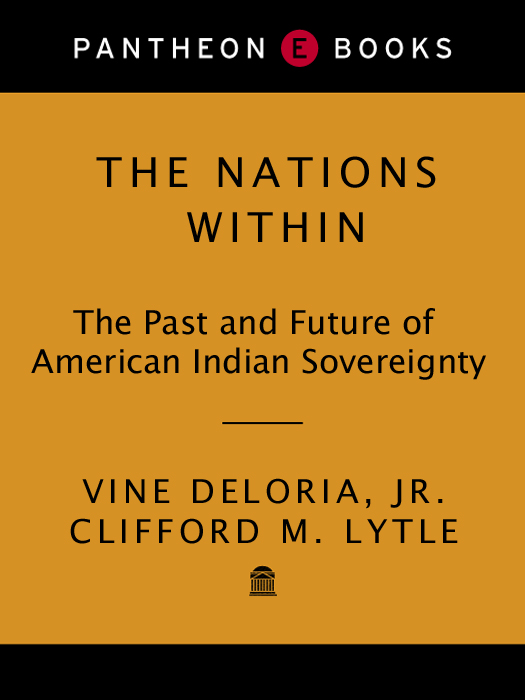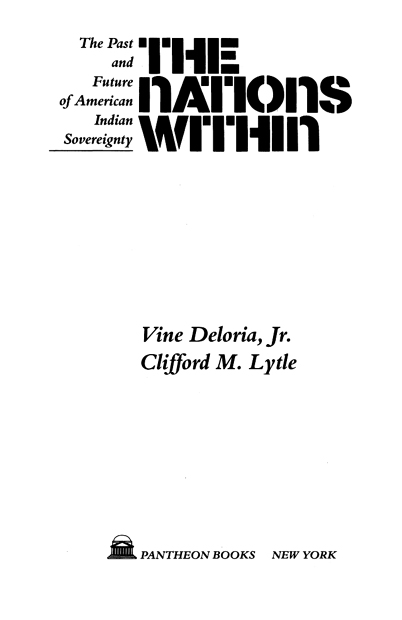Copyright 1984 by Vine Deloria, Jr. & Clifford M. Lytle
All rights reserved under International and Pan-American Copyright Conventions. Published in the United States by Pantheon Books, a division of Random House, Inc., New York, and simultaneously in Canada by Random House of Canada Limited, Toronto.
Library of Congress Cataloging in Publication Data
Deloria, Vine.
The nations within.
Bibliography: p.
1. Indians of North AmericaTribal government. 2. Indians of North AmericaGovernment relations1934 . 3. Indians of North AmericaCivil rights.
I. Lytle, Clifford M. II. Title.
E98.T77D44 1984 323.1197 84-42663
eISBN: 978-0-307-83184-2
v3.1
1
A Status Higher Than States
It must be a bit disconcerting when the average American on vacation out west suddenly encounters a sign that boldly proclaims that the highway is entering an Indian nation. We like to think of nations on a much larger scalepreferably an ocean away, with all the hustle and bustle of modern, industrial, institutional life. Nations have different languages, religions, customs, and holidays from our own; they represent a mass of people who have struggled for centuries to create institutions that presently serve them. Indian tribes have some of the attributes we find familiar in other nations; language, religion, and social customs certainly set them apart from other Americans. But we miss the massive crowd of people, the well-developed lands, the military and economic power that we see in larger nations. And so, when the idea of Indian tribes as nations is voiced, many Americans laugh at the pretension, convinced that Indians have some primitive delusion of grandeur that has certainly been erased by history.
Indian affairs constitute but a minute part of the domestic American sceneso small a share, in fact, that federal Indian legislation no longer even rates a permanent subcommittee in either house of Congress. It is not difficult to see that although Indians are poor and generally live in isolated places in rural America, they are not in most respects radically different from other Americans living in the same circumstances. In fact, one might observe, most Indians are not distinguishable from other Americans except on those occasions when they shed working clothes and perform dances in fancy costumes for touristsfor a small entrance fee, of course. If this occasional ceremonial, the meaning of which has been lost in the past century and replaced by the commercial powwow, is all that distinguishes Indians from other Americans, why do Indians believe they are different? And why does the United States government treat them differently?
Modern social reality and historical political reality are rarely consonant with each other. Contemporary Indian communities, both reservation and urban, represent the continuing existence of a particular group of people who have traditionally had a moral and legal claim against the United States. The fact that many Indian tribes continue to exist unassimilated is not due to the practice of traditional ceremonies as much as it testifies to the complex of legal and political ideas that have surrounded Indians for two centuries and made them understand the world in much different terms from any other group of American citizens.
American Indians are unique in the world in that they represent the only aboriginal peoples still practicing a form of self-government in the midst of a wholly new and modern civilization that has been transported to their lands. Early in the period of discovery of the New World, the papacy articulated the Doctrine of Discovery, which announced that Christian princes discovering new lands had a recognized title to them, subject only to the willingness of the original inhabitants to sell their lands to the discoverer. Because of such principlesand in spite of the history of exploitation and conquest represented by American settlement of North AmericaAmerican Indians have actually been treated considerably better than any other aboriginal group on any other continent.
The United States, after successfully revolting against the king of England, claimed to inherit Great Britains right to buy the lands of the Indians, and this doctrine, modified to fit the internal, domestic law of the United States, has been the primary conceptual focus for all subsequent federal Indian law. Every legal doctrine that today separates and distinguishes American Indians from other Americans traces its conceptual roots back to the Doctrine of Discovery and the subsequent moral and legal rights and responsibilities of the United States with respect to Indians.
Under the Constitution, Congress is given exclusive power to regulate commerce with foreign nations, among the several states, and Among other powers and privileges ceded to the national government with the adoption of the Constitution was the surrender by the states of the subject of Indians. New York State and several other former coloniesspecifically, Virginia and Massachusettspreserved the right to continue to deal with Indian tribes for whom they had already assumed some responsibility. But these relationships were themselves based upon the old Doctrine of Discovery and represented a long series of treaty agreements in which the coloniesnow states, with the adoption of the Constitutionagreed to protect the tribes from the depredations of their own citizens. There is no inherent power in any of the fifty states to deal with Indians at all.
One good way to view the subsequent history of the United States is through the eyes of the federal government in dealing with Indians and Indian rights. Much of the federal-state conflict has revolved around the role of the federal government in protecting its primacy with respect to Indian affairs. Pressures on the frontier for free lands, the extension of slavery into land unsuitable for cotton production, the aggressive gold rushes, the need for a suitable water law on western lands, and the authorization and construction of railroadsall these activities were hampered by and influenced by the role of the federal government toward Indians. Settlement was chaotic, but in a sense systematically so, in that many activities were delayed while the government dealt with the tribes who occupied and defended various parts of the continent.
The Constitution mentions Indians as an identifiable group twice: once in the provision for determining representation in the Congress and the second time when this phrase is repeated in the Fourteenth Amendment. Indians in these instances are viewed as individuals: Indians not taxed, a phrase that testifies to the idea that Indians, as individuals, could be assimiliated into the body politic, providing they assumed the ordinary citizenship responsibilities. In the world of Anglo-Saxon property owners this meant paying taxes. Indians not paying taxes are not to be enumerated when determining the population of each state, and the presumption is that those Indians immune from state and federal taxes are in some kind of political allegiance to their own tribes, submitting to whatever strictures that tribe or society is able to impose on its members. Therefore these Indians are outside the reach of American sovereignty and its taxing power.
This interpretation is further supported by the language of the Indian Citizenship Act of 1924,which is not to be hindered in either respect: Indians are not to lose civil rights because of their status as members of a tribe, and members of a tribe are not to be denied their tribal rights because of their American citizenship. Unfortunately, this distinction has not often been preserved, and in the 1920s, and again in the 1950s, Congress attempted to sever unilaterally the political relationship between Indian tribes and the United States, using the citizenship of individual Indians as its excuse.



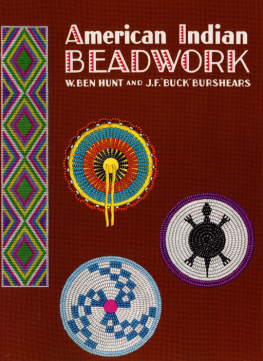

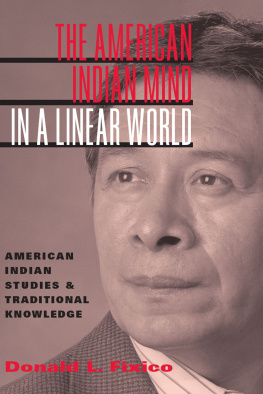
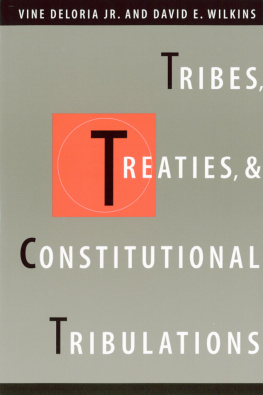
![Deloria Jr. - Behind the trail of broken treaties an Indian declaration of independence. [The goundbreaking work by the preeminent spokesperson for American Indian rights]](/uploads/posts/book/171989/thumbs/deloria-jr-behind-the-trail-of-broken-treaties.jpg)
